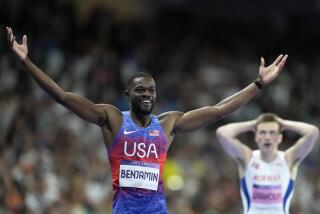THIS ONE IS STILL STANDING : But Bob Beamon Is Convinced Record in Long Jump Will Fall
- Share via
And then there was one.
On Aug. 17 Butch Reynolds reminded everybody that there are few constants in the universe of track and field by breaking Lee Evans 20-year-old record in the 400-meter run.
That left standing only one record from the Mexico City Olympics -- Bob Beamon’s 29 foot 2 1/2 inch skywalk.
Evans and Beamon set their records on the same day, Oct. 18, 1968, and although both were considered astounding at the time, Beamon is convinced his mark will also fall.
“Somewhere, sometime the record will be broken. There are two or three athletes around now with the form and talent to eventually erase 29 feet 2 1/2 inches,” Beamon said.
Carl Lewis, who won four gold medals in the 1984 Olympics and will compete again in Seoul, has leaped 28-10; Larry Myricks has made it to 28-8. A Soviet jumper, Robert Emmiyan, made it to 29-1 at altitude last year.
Reynolds had looked like he was ready to break through Evans’ 43.86 for a year and finally did it in Zurich, lowering the mark by more than half a second to 43.29.
Although the 7,350-foot altitude in Mexico City helped, Beamon’s record was not an illusion. Experts in physical motion have analyzed Beamon’s approach and liftoff and called it the technically perfect jump.
Even if the record is broken at the Olympics in Seoul, however, the circumstances are not likely to be as dramatic and the mental pressures are not likely to be the same.
Beamon and Evans performed only 24 hours after sprinters Tommie Smith and John Carlos were disqualified by the U.S. Olympic Committee because of the black-gloved, clench-fited salute they gave while accepting the gold and bronze medals in the 200-meter dash.
The world stage of the Olympics magnified the gesture, making it more effective than anyone had imagined.
“It was taken as an insult, maybe it could have been done better,” Beamon says now. “It was saying in a nonviolent way that we were not being treated fairly. We were all seriously involved in civil rights.”
Evans had been a leader of the black athletes protesting racial discrimination in the United States. He did not raise his fist during the national anthem, but wore black socks as a gesture of solidarity.
“Nowadays holding up your fist is being used by everybody. It’s not anything to get alarmed about,” Beamon said during a recent interview in New York.
The situation helped push Beamon, and so did the competition -- Ralph Boston and Soviet jumper Igor Ter-Ovanesyan, who jointly held the former record, 27-4 3/4, and East German Klaus Beer.
“My adrenaline was going to work, that can only make you jump better,” Beamon said. “I felt positive that I was going to win and never, ever would doubt myself.”
Beamon also feels the 1968 track and field team was the best U.S. Olympic squad until this year, and that helped him break the record on his first try.
“Part of it is being part of the team. That 1968 team, we were very close with each other. Every chance I get I like to see those guys,” he said.
Beamon believes that the preparation of the team is likely to be better this year than it was in 1968 because of such things as corporate sponsorship, which has allowed full time training in track and field.
“It’s much better for the athletes,” he said, recalling the way some team members had to struggle to make a living as they tried to lift themselves to a world standard of excellence.
Since those Olympics, Beamon has traveled, working as a coach, and lived in Spain for two years. “I was interested in something different than competing,” he said.
Evans has spent the last several years coaching in Africa, most recently as a Fulbright professor of sports in Cameroon, according to Valerie Kreutzer, a program development officer at the U.S. Information Agency. He has coached in as many as 15 countries, she said.
“He is a hero in track all over Africa. You drop that name and they clamor for him,” Kreutzer said.
Evans, who could not be located by telephone in Nigeria or Cameroon, may indirectly have helped Reynolds break the record by coaching Nigerian Innocent Egbunike. Reynolds credited Egbunike for setting a world record pace over the first 200 meters in Zurich, although Egbunike eventually faded to sixth.
“Lee had been hoping Egbunike would break the record,” Kreutzer said.
Beamon has not named a favorite, and if he goes to Seoul this year he will be interested in more than the outcome of the long jump. The man who created one of the Olympics’ most memorable moments is a fanatic collector of Olympic memorabilia.
“I’ll take everything I can get,” he said. He says he has no particular favorite and tries to avoid swapping away even the smallest Olympic pin.
At a recent pre-Olympic dinner he spotted some small versions of Hodori, the smiling orange tiger who is mascot of the Seoul Olympics, and left clutching three.
“One for my wife,” he said, smiling.
More to Read
Go beyond the scoreboard
Get the latest on L.A.'s teams in the daily Sports Report newsletter.
You may occasionally receive promotional content from the Los Angeles Times.






